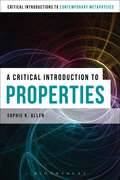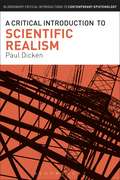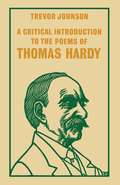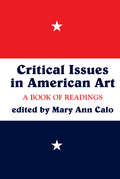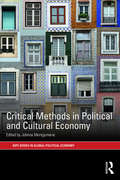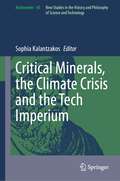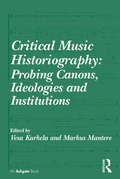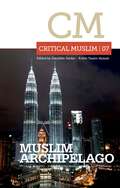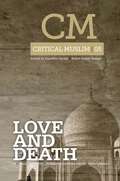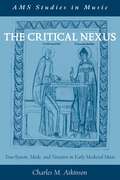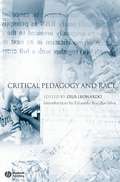- Table View
- List View
A Critical Introduction to Properties (Bloomsbury Critical Introductions to Contemporary Metaphysics)
by Sophie AllenWhat do blue things have in common? Or electrons? Or planets? Distinct things appear to share properties; but what are properties and what is the best philosophical account of them? A Critical Introduction to Properties introduces different ontological accounts of properties, exploring how their formulation is shaped by the explanatory demands placed upon them.This accessible introduction begins with a discussion of universals, tropes, sets and resemblance classes, the major objections to them and their responses, providing readers with a firm grasp on the competing ontological accounts of what (if anything) grounds similarity and difference. It then explores issues concerning the formulation and justification of property theories such as: how many properties are there? Should we accept a sparse ontology of properties, or an abundant one? Can we make a distinction between intrinsic and extrinsic properties? Do properties have their causal roles necessarily? What is the relationship between properties and other metaphysical phenomena such as causality, laws and modality? These questions get to the heart of why a coherent theory of properties is so important to metaphysics, and to philosophy more generally.By concluding with the question of the ontological status of properties, the reader is introduced to some Carnapian and contemporary themes about the content and methodology of metaphysics. For students looking for an accessible resource and a more comprehensive understanding of contemporary metaphysics, A Critical Introduction to Properties is a valuable starting point.
A Critical Introduction to Properties (Bloomsbury Critical Introductions to Contemporary Metaphysics)
by Sophie AllenWhat do blue things have in common? Or electrons? Or planets? Distinct things appear to share properties; but what are properties and what is the best philosophical account of them? A Critical Introduction to Properties introduces different ontological accounts of properties, exploring how their formulation is shaped by the explanatory demands placed upon them.This accessible introduction begins with a discussion of universals, tropes, sets and resemblance classes, the major objections to them and their responses, providing readers with a firm grasp on the competing ontological accounts of what (if anything) grounds similarity and difference. It then explores issues concerning the formulation and justification of property theories such as: how many properties are there? Should we accept a sparse ontology of properties, or an abundant one? Can we make a distinction between intrinsic and extrinsic properties? Do properties have their causal roles necessarily? What is the relationship between properties and other metaphysical phenomena such as causality, laws and modality? These questions get to the heart of why a coherent theory of properties is so important to metaphysics, and to philosophy more generally.By concluding with the question of the ontological status of properties, the reader is introduced to some Carnapian and contemporary themes about the content and methodology of metaphysics. For students looking for an accessible resource and a more comprehensive understanding of contemporary metaphysics, A Critical Introduction to Properties is a valuable starting point.
A Critical Introduction to Scientific Realism (Bloomsbury Critical Introductions to Contemporary Epistemology)
by Paul DickenWhat are the reasons for believing scientific theories to be true? The contemporary debate around scientific realism exposes questions about the very nature of scientific knowledge. A Critical Introduction to Scientific Realism explores and advances the main topics of the debate, allowing epistemologists to make new connections with the philosophy of science.Moving from its origins in logical positivism to some of the most recent issues discussed in the literature, this critical introduction covers the no-miracles argument, the pessimistic meta-induction and structural realism. Placing arguments in their historical context, Paul Dicken approaches scientific realism debate as a particular instance of our more general epistemological investigations. The recurrent theme is that the scientific realism debate is in fact a pseudo-philosophical question.Concerned with the methodology of the scientific realism debate, Dicken asks what it means to offer an epistemological assessment of our scientific practices. Taking those practices as a guide to our epistemological reflections, A Critical Introduction to Scientific Realism fills a gap in current introductory texts and presents a fresh approach to understanding a crucial debate.
A Critical Introduction to Scientific Realism (Bloomsbury Critical Introductions to Contemporary Epistemology)
by Paul DickenWhat are the reasons for believing scientific theories to be true? The contemporary debate around scientific realism exposes questions about the very nature of scientific knowledge. A Critical Introduction to Scientific Realism explores and advances the main topics of the debate, allowing epistemologists to make new connections with the philosophy of science.Moving from its origins in logical positivism to some of the most recent issues discussed in the literature, this critical introduction covers the no-miracles argument, the pessimistic meta-induction and structural realism. Placing arguments in their historical context, Paul Dicken approaches scientific realism debate as a particular instance of our more general epistemological investigations. The recurrent theme is that the scientific realism debate is in fact a pseudo-philosophical question.Concerned with the methodology of the scientific realism debate, Dicken asks what it means to offer an epistemological assessment of our scientific practices. Taking those practices as a guide to our epistemological reflections, A Critical Introduction to Scientific Realism fills a gap in current introductory texts and presents a fresh approach to understanding a crucial debate.
Critical Issues In American Art: A Book Of Readings
by Mary Ann CaloThis anthology of essays on different critical approaches and methodologies for the analysis and interpretation of American art and artists is designed for students and teachers in American art history and American studies programs. It contains twenty selections from academic journals on American art from colonial times to 1940. Mary Ann Calo provides an introduction to the anthology, explaining its purpose and organization, and each selection has a brief introduction about its main focus and scholarly approach. These case studies show the diversity of scholarly thinking about interpreting American works of art, which should be useful for teachers and comprehensible and interesting for students.This anthology contains twenty articles on American art from colonial times to 1940. The selections are mainly from academic journals and aim to provide the student and teacher with different critical approaches and methodologies for the analysis and interpretation of American art and artists. Mary Ann Calo's preface to the anthology explains its purpose and organization, and each article will have a brief introduction about its main focus and scholarly approach.This text meets the need in American art history studies for an anthology of essays on critical approaches and methodologies.
Critical Issues in Contemporary China: Unity, Stability and Development
by Czeslaw TubilewiczCritical Issues in Contemporary China: Unity, Stability and Development comprehensively examines key problems crucial to understanding modern-day China. Organized around three interrelated themes of unity, stability and development, each chapter explores distinct issues and debate their significance for China domestically and for Beijing’s engagement with the wider world. While presenting contending explanatory approaches, contributors advance arguments to further critical discussion on selected topics. Main issues analysed include: political change military transformation legal reforms economic development energy security environmental degradation food security and safety demographic trends migration and urbanization labour unrest health and education social inequalities ethnic conflicts Hong Kong’s integration cross-Strait relations. Given its thorough and up-to-date assessment of major political, social and economic challenges facing China, this fully revised and substantially expanded new edition is an essential read for any student of Chinese Studies.
Critical Issues in Contemporary China: Unity, Stability and Development
by Czeslaw TubilewiczCritical Issues in Contemporary China: Unity, Stability and Development comprehensively examines key problems crucial to understanding modern-day China. Organized around three interrelated themes of unity, stability and development, each chapter explores distinct issues and debate their significance for China domestically and for Beijing’s engagement with the wider world. While presenting contending explanatory approaches, contributors advance arguments to further critical discussion on selected topics. Main issues analysed include: political change military transformation legal reforms economic development energy security environmental degradation food security and safety demographic trends migration and urbanization labour unrest health and education social inequalities ethnic conflicts Hong Kong’s integration cross-Strait relations. Given its thorough and up-to-date assessment of major political, social and economic challenges facing China, this fully revised and substantially expanded new edition is an essential read for any student of Chinese Studies.
Critical Issues in Contemporary China: Decoding Xi Jinping’s ‘New Era’
by Czeslaw TubilewiczThe third edition of Critical Issues in Contemporary China offers an in-depth and up-to-date analysis of Xi Jinping’s strategies to address critical domestic and international challenges facing China in a ‘new era’.This book joins the current debates about Xi Jinping’s ‘new era’, reflecting upon the continuity and change in the CCP’s domestic and foreign policies under Xi’s leadership and Xi’s capacity to realize the Chinese Dream of national rejuvenation. The international team of contributors evaluate such pressing issues as: Xi’s re-centralization of power and securitization of domestic politics the Chinese economic model state-civil society relations Xi’s gender policy and return to the traditional family values Beijing’s responses to unrest in Xinjiang and Hong Kong Xi’s evolving unification strategies towards Taiwan the Belt and Road Initiative, and the deterioration of US-China relations. Providing readers with rich empirical assessment of Xi’s responses to the political, economic, social and international challenges facing contemporary China, the third edition of Critical Issues will be an essential resource for students of Chinese politics, economy, society and foreign relations.
Critical Issues in Contemporary China: Decoding Xi Jinping’s ‘New Era’
by Czeslaw TubilewiczThe third edition of Critical Issues in Contemporary China offers an in-depth and up-to-date analysis of Xi Jinping’s strategies to address critical domestic and international challenges facing China in a ‘new era’.This book joins the current debates about Xi Jinping’s ‘new era’, reflecting upon the continuity and change in the CCP’s domestic and foreign policies under Xi’s leadership and Xi’s capacity to realize the Chinese Dream of national rejuvenation. The international team of contributors evaluate such pressing issues as: Xi’s re-centralization of power and securitization of domestic politics the Chinese economic model state-civil society relations Xi’s gender policy and return to the traditional family values Beijing’s responses to unrest in Xinjiang and Hong Kong Xi’s evolving unification strategies towards Taiwan the Belt and Road Initiative, and the deterioration of US-China relations. Providing readers with rich empirical assessment of Xi’s responses to the political, economic, social and international challenges facing contemporary China, the third edition of Critical Issues will be an essential resource for students of Chinese politics, economy, society and foreign relations.
Critical Issues in Israeli Society (Praeger Series on Jewish and Israeli Studies)
by Alan DowtyFashioning a working political structure in Israel that will bring together all aspects of society, from Jews to Arabs, ultra-Orthodox to assertively secular, has never been easy. However, two developments have intensified this challenge: demographic changes have sharpened the differences between the groups; and open challenges of legitimacy have undermined the previous de facto acceptance of pluralism. There has been no strong civic framework of Israeliness to replace Zionism as a shared identity that would override more parochial identities and interests. Added to these pressures are the collapse of the peace process in late 2000 and the influence of global developments on the Arab-Israel conflict and on Israeli domestic society.In this volume, twelve noted scholars of Israel present authoritative and analytic overviews of these important issues. The ability of the Israeli political system to bridge differences through a Jewish tradition of power-sharing has, in the past, managed to overcome enormous divisions, at least within the Jewish sector. Economic progress and globalization have brought Israel closer to other developed societies in many respects, while exposing Israel to pressures associated with these trends. Closer analysis of these critical issues reveals that there are also positive forces at work as the nation seeks a broader synthesis of its Jewish legacy and universal liberal values.
Critical Junctions: Anthropology and History beyond the Cultural Turn
by Don Kalb Herman TakThe “cultural turn” has been a multifarious and pervasive phenomenon in Western universities and modes of social knowledge since the early 1980s. This volume focuses on the conjunction of two disciplines where both the analytic promises as well as the difficulties involved in the meeting of humanist and social science approaches soon became obvious. Anthropologists and historians have come together here in order to recapture, elaborate, and criticize pre-Cultural Turn and non-Cultural Turn modes of analysing structures of experience, feeling, subjectivity and action in human societies and to highlight the still unexploited possibilities developed among others in the work of scholars such as Norbert Elias, Max Gluckman, Eric Wolf, E.P. Thompson and Raymond Williams.
Critical Methods in Political and Cultural Economy (RIPE Series in Global Political Economy)
by Johnna MontgomerieCritical Methods in Political and Cultural Economy offers students and scholars the first methods book for the critical school of International Political Economy (IPE). What does it mean to ‘do’ critical research? How do we write about the evidence we present? This volume explores our shared critical ethic to demonstrate how methods are transformative and reimagines research strategies as both an embodied practice and a social process. By presenting methodologically informed ways of researching, enriched by real-life accounts from academics doing empirical research, the volume seeks to forge a new collaborative path that builds a critical ethic and modes of inquiry within International Political Economy. Substantive chapters advance the pluralism of the critical school of cultural political economy and seek to articulate its nascent research ethic. Short autobiographical vignettes articulate the professional journeys of contributors who ‘do’ critical political economy. There is practical advice on how to develop evidence from an iterative reflexive research strategy. Using this innovative format offers a guide to methods in critical political economy by engaging directly with the people doing research, not only as technical practice but also as lived experience. The combination of research and practice presented throughout the book offers an extensive and authoritative framework for evaluating how methods are part of critical research and will be essential reading for all students and scholars of IPE.
Critical Minerals, the Climate Crisis and the Tech Imperium (Archimedes #65)
by Sophia KalantzakosThis book examines the latest manifestations of resource competition. The energy transition and the digitalization of the global economy are both accelerating even as geopolitics driven by Sino-American hyper-competition become increasingly contentious. The volume brings together an interdisciplinary group of scholars, policy makers, institutional stakeholders, and industry experts to analyze not only the transition itself, but also the implications that the need for uninterrupted access to unprecedented levels of raw materials generates. By framing the challenges ahead for global society, governance, industry, international power politics, and the environment, the book asks hard questions about the choices that need to be made to reach net zero by mid-century. Moreover, it sheds light on different facets of the growing risks to what have been global interdependent supply chains in a way that is nuanced, balanced, and practical, thus pushing back on some of the most sensational headlines that breed confusion and may lead policymakers to make more narrow and less effective decisions. The volume is an outcome of “Rich Rocks, the Climate Crisis and the Tech-imperium” a Summer Institute at Caltech and the Huntington that took place in July 2021.
Critical Music Historiography: Probing Canons, Ideologies and Institutions
by Vesa Kurkela Markus MantereDuring the past two decades, there has emerged a growing need to reconsider the objects, axioms and perspectives of writing music history. A certain suspicion towards Francois Lyotard’s grand narratives, as a sign of what he diagnosed as our ’postmodern condition’, has become more or less an established and unquestioned point of departure among historians. This suspicion, at its most extreme, has led to a radical conclusion of the ’end of history’ in the work of postmodern scholars such as Jean Baudrillard and Francis Fukuyama. The contributors to Critical Music Historiography take a step back and argue that the radical view of the ’impossibility of history’, as well as the unavoidable ideology of any history, are counter-productive points of departure for historical scholarship. It is argued that metanarratives in history are still possible and welcome, even if their limitations are acknowledged. Foucault, Lyotard and others should be taken into account but systematized viewpoints and methods for a more critical and multi-faceted re-evaluation of the past through research are needed. As to the metanarratives of music history, they must avoid the pitfalls of evolutionism, hagiography, and teleology, all hallmarks of traditional historiography. In this volume the contributors put these methods and principles into practice. The chapters tackle under-researched and non-conventional domains of music history as well as rethinking older historiographical concepts such as orientalism and nationalism, and consequently introduce new concepts such as occidentalism and transnationalism. The volume is a challenging collection of work that stakes out a unique territory for itself among the growing body of work on critical music history.
Critical Music Historiography: Probing Canons, Ideologies and Institutions
by Vesa Kurkela Markus MantereDuring the past two decades, there has emerged a growing need to reconsider the objects, axioms and perspectives of writing music history. A certain suspicion towards Francois Lyotard’s grand narratives, as a sign of what he diagnosed as our ’postmodern condition’, has become more or less an established and unquestioned point of departure among historians. This suspicion, at its most extreme, has led to a radical conclusion of the ’end of history’ in the work of postmodern scholars such as Jean Baudrillard and Francis Fukuyama. The contributors to Critical Music Historiography take a step back and argue that the radical view of the ’impossibility of history’, as well as the unavoidable ideology of any history, are counter-productive points of departure for historical scholarship. It is argued that metanarratives in history are still possible and welcome, even if their limitations are acknowledged. Foucault, Lyotard and others should be taken into account but systematized viewpoints and methods for a more critical and multi-faceted re-evaluation of the past through research are needed. As to the metanarratives of music history, they must avoid the pitfalls of evolutionism, hagiography, and teleology, all hallmarks of traditional historiography. In this volume the contributors put these methods and principles into practice. The chapters tackle under-researched and non-conventional domains of music history as well as rethinking older historiographical concepts such as orientalism and nationalism, and consequently introduce new concepts such as occidentalism and transnationalism. The volume is a challenging collection of work that stakes out a unique territory for itself among the growing body of work on critical music history.
Critical Muslim 07: Muslim Archipelago (Critical Muslim Ser.)
by Ziauddin Sardar and Robin Yassin-KassabMalaysia and Indonesia are seen as bastions of liberal Islam. Is this really true or simply a widely held misconception about south-east Asian Muslims? What is the contribution of the Muslim archipelago to the world of Islam? What can we learn from Malaysian and Indonesian experiments in democracy? This issue of Critical Muslim addresses these questions by examining the politics, history, culture and religious traditions of Malaysia and Indonesia. Contributors include Merryl Wyn Davies on Malaysian multiculturalism, Luthfi Assyaukanie on Indonesia politics, Carool Kersten on the struggles of Indonesian intellectuals, Andre Vltchek on religion and tolerance in south-east Asia, Andi Achdian on Islam in Java, Ahmad Fuad Rahmat on the Malaysian intellectual guru Naguib Al-Attas, Shanon Shah on Malay Magic, Jo Kukathas on 'Malay-ness', Linda Christanty on literary stars of Indonesia, Rossie Indira on Indonesian pop music, and Nazry Bahrawi on reformist debates in south-east Asia. About Critical Muslim: A quarterly publication of ideas and issues showcasing groundbreaking thinking on Islam and what it means to be a Muslim in a rapidly changing, interconnected world. Each edition centers on a discrete theme, and contributions include reportage, academic analysis, cultural commentary, photography, poetry, and book reviews.
Critical Muslim 07: Muslim Archipelago
Malaysia and Indonesia are seen as bastions of liberal Islam. Is this really true or simply a widely held misconception about south-east Asian Muslims? What is the contribution of the Muslim archipelago to the world of Islam? What can we learn from Malaysian and Indonesian experiments in democracy? This issue of Critical Muslim addresses these questions by examining the politics, history, culture and religious traditions of Malaysia and Indonesia. Contributors include Merryl Wyn Davies on Malaysian multiculturalism, Luthfi Assyaukanie on Indonesia politics, Carool Kersten on the struggles of Indonesian intellectuals, Andre Vltchek on religion and tolerance in south-east Asia, Andi Achdian on Islam in Java, Ahmad Fuad Rahmat on the Malaysian intellectual guru Naguib Al-Attas, Shanon Shah on Malay Magic, Jo Kukathas on 'Malay-ness', Linda Christanty on literary stars of Indonesia, Rossie Indira on Indonesian pop music, and Nazry Bahrawi on reformist debates in south-east Asia. About Critical Muslim: A quarterly publication of ideas and issues showcasing groundbreaking thinking on Islam and what it means to be a Muslim in a rapidly changing, interconnected world. Each edition centers on a discrete theme, and contributions include reportage, academic analysis, cultural commentary, photography, poetry, and book reviews.
Critical Muslim 5: Love and Death (Critical Muslim Ser.)
by Great RussellAamer Hussein takes love to its logical conclusion, Robert Irwin traces the origins of the ghazal (love lyric), Christopher Shackle recites epic Panjabi poems of sacred love and lyrical death, Imranali Panjwani mourns the massacre of Karbala, Martin Rose istaken hostage by Saddam Hussein, Jalees Rahman reflects on Nazi doctors who took delight in deathly experiments, Ramin Jahanbegloo is incarcerated in the notorious Evin prison, Hamza Elahi visits England's Muslim graveyards, Shanon Shah receives valuable guidance on love and sex from the "Obedient Wives Club", Samia Rahman sets out in search of love, Khola Hasan has mixed feelings about her hijab, Sabita Manian promotes love between India and Pakistan, Boyd Tonkin discovers that dead outrank the living in Jerusalem , Alev Adil takes "a night journey through a veiled self" and Irna Qureshi's mother finally makes a decision on her final resting place. Also in this issue: Parvez Manzoor throws scorn on a nihilistic, revisionist history of Islam, Naomi Foyle reads the first novel of a British Palestinian, Ahmad Khan explores the colonial history of The Aborigines' Protection Society, a short story by the famous Fahmida Riaz, Syrian scenarios by Manhal al-Sarraj, poems by Sabrina Mahfouz and Michael Wolf, Rachel Dwyer's list of Top Ten Muslim Characters in Bollywood and Merryl Wyn Davies's "last word" on love and death at the movies. About Critical Muslim: A quarterly publication of ideas and issues showcasing groundbreaking thinking on Islam and what it means to be a Muslim in a rapidly changing, interconnected world. Each edition centers on a discrete theme, and contributions include reportage, academic analysis, cultural commentary, photography, poetry, and book reviews.
Critical Muslim 5: Love and Death
Aamer Hussein takes love to its logical conclusion, Robert Irwin traces the origins of the ghazal (love lyric), Christopher Shackle recites epic Panjabi poems of sacred love and lyrical death, Imranali Panjwani mourns the massacre of Karbala, Martin Rose istaken hostage by Saddam Hussein, Jalees Rahman reflects on Nazi doctors who took delight in deathly experiments, Ramin Jahanbegloo is incarcerated in the notorious Evin prison, Hamza Elahi visits England's Muslim graveyards, Shanon Shah receives valuable guidance on love and sex from the "Obedient Wives Club", Samia Rahman sets out in search of love, Khola Hasan has mixed feelings about her hijab, Sabita Manian promotes love between India and Pakistan, Boyd Tonkin discovers that dead outrank the living in Jerusalem , Alev Adil takes "a night journey through a veiled self" and Irna Qureshi's mother finally makes a decision on her final resting place. Also in this issue: Parvez Manzoor throws scorn on a nihilistic, revisionist history of Islam, Naomi Foyle reads the first novel of a British Palestinian, Ahmad Khan explores the colonial history of The Aborigines' Protection Society, a short story by the famous Fahmida Riaz, Syrian scenarios by Manhal al-Sarraj, poems by Sabrina Mahfouz and Michael Wolf, Rachel Dwyer's list of Top Ten Muslim Characters in Bollywood and Merryl Wyn Davies's "last word" on love and death at the movies. About Critical Muslim: A quarterly publication of ideas and issues showcasing groundbreaking thinking on Islam and what it means to be a Muslim in a rapidly changing, interconnected world. Each edition centers on a discrete theme, and contributions include reportage, academic analysis, cultural commentary, photography, poetry, and book reviews.
The Critical Nexus: Tone-System, Mode, and Notation in Early Medieval Music (AMS Studies in Music)
by Charles M. AtkinsonThe Critical Nexus confronts an important and vexing enigma of early writings on music: why chant, which was understood to be divinely inspired, needed to be altered in order to work within the then-operative modal system. To unravel this mystery, Charles Atkinson creates a broad framework that moves from Greek harmonic theory to the various stages in the transmission of Roman chant, citing numerous music treatises from the sixth to the twelfth century. Out of this examination emerges the central point behind the problem: the tone-system advocated by writers coming from the Greek harmonic tradition was not suited to the notation of chant and that this basic incompatibility led to the creation of new theoretical constructs. By tracing the path of subsequent adaptation at the nexus of tone-system, mode, and notation, Atkinson promises new and far-reaching insights into what mode meant to the medieval musician and how the system responded to its inherent limitations. Through a detailed examination of the major musical treatises from the sixth through the twelfth centuries, this text establishes a central dichotomy between classical harmonic theory and the practices of the Christian church. Atkinson builds the foundation for a broad and original reinterpretation of the modal system and how it relates to melody, grammar, and notation. This book will be of interest to all musicologists, music theorists working on mode, early music specialists, chant scholars, and medievalists interested in music.
The Critical Nexus: Tone-System, Mode, and Notation in Early Medieval Music (AMS Studies in Music)
by Charles M. AtkinsonThe Critical Nexus confronts an important and vexing enigma of early writings on music: why chant, which was understood to be divinely inspired, needed to be altered in order to work within the then-operative modal system. To unravel this mystery, Charles Atkinson creates a broad framework that moves from Greek harmonic theory to the various stages in the transmission of Roman chant, citing numerous music treatises from the sixth to the twelfth century. Out of this examination emerges the central point behind the problem: the tone-system advocated by writers coming from the Greek harmonic tradition was not suited to the notation of chant and that this basic incompatibility led to the creation of new theoretical constructs. By tracing the path of subsequent adaptation at the nexus of tone-system, mode, and notation, Atkinson promises new and far-reaching insights into what mode meant to the medieval musician and how the system responded to its inherent limitations. Through a detailed examination of the major musical treatises from the sixth through the twelfth centuries, this text establishes a central dichotomy between classical harmonic theory and the practices of the Christian church. Atkinson builds the foundation for a broad and original reinterpretation of the modal system and how it relates to melody, grammar, and notation. This book will be of interest to all musicologists, music theorists working on mode, early music specialists, chant scholars, and medievalists interested in music.
Critical Pedagogy and Race
by Zeus LeonardoCritical Pedagogy and Race argues that a rigorous engagement with race is a priority for educators concerned with equality in schools and in society. A landmark collection arguing that engaging with race at both conceptual and practical levels is a priority for educators. Builds a stronger engagement of race-based analysis in the field of critical pedagogy. Brings together a melange of theories on race, such as Afro-centric, Latino-based, and postcolonial perspectives. Includes historical studies, and social justice ideas on activism in education. Questions popular concepts, such as white privilege, color-blind perspectives, and race-neutral pedagogies.
Critical Perspectives on Colonialism: Writing the Empire from Below (Routledge Studies in Cultural History)
by Fiona Paisley Kirsty ReidThis collection brings much-needed focus to the vibrancy and vitality of minority and marginal writing about empire, and to their implications as expressions of embodied contact between imperial power and those negotiating its consequences from "below." The chapters explore how less powerful and less privileged actors in metropolitan and colonial societies within the British Empire have made use of the written word and of the power of speech, public performance, and street politics. This book breaks new ground by combining work about marginalized figures from within Britain as well as counterparts in the colonies, ranging from published sources such as indigenous newspapers to ordinary and everyday writings including diaries, letters, petitions, ballads, suicide notes, and more. Each chapter engages with the methodological implications of working with everyday scribblings and asks what these alternate modernities and histories mean for the larger critique of the "imperial archive" that has shaped much of the most interesting writing on empire in the past decade.
Critical Perspectives on Colonialism: Writing the Empire from Below (Routledge Studies in Cultural History)
by Fiona Paisley Kirsty ReidThis collection brings much-needed focus to the vibrancy and vitality of minority and marginal writing about empire, and to their implications as expressions of embodied contact between imperial power and those negotiating its consequences from "below." The chapters explore how less powerful and less privileged actors in metropolitan and colonial societies within the British Empire have made use of the written word and of the power of speech, public performance, and street politics. This book breaks new ground by combining work about marginalized figures from within Britain as well as counterparts in the colonies, ranging from published sources such as indigenous newspapers to ordinary and everyday writings including diaries, letters, petitions, ballads, suicide notes, and more. Each chapter engages with the methodological implications of working with everyday scribblings and asks what these alternate modernities and histories mean for the larger critique of the "imperial archive" that has shaped much of the most interesting writing on empire in the past decade.
